TOYOTA PRIUS C 2020 Owners Manual
Manufacturer: TOYOTA, Model Year: 2020, Model line: PRIUS C, Model: TOYOTA PRIUS C 2020Pages: 600, PDF Size: 12.02 MB
Page 201 of 600

2014-2. Driving procedures
4
Driving
PRIUS c_U■
Automatic cancelation of EV drive mode
When driving in EV drive mode, the gasoline engine may automati cally restart
in the following situations. When EV drive mode is canceled, a buzzer will
sound and the EV drive mode indicator will flash and go off.
● The hybrid battery (traction battery) becomes low.
The remaining battery level indicated in the energy monitor dis play is low.
( P. 112)
● Vehicle speed is high.
● The accelerator pedal is depressed firmly or the vehicle is on a hill etc.
■ Possible driving distance when driving in EV drive mode
EV drive mode’s possible driving distance ranges from a few hun dred meters
to approximately 1.3 miles (2 km). However, depending on vehicle conditions,
there are situations when EV drive mode cannot be used.
(The distance that is possible depends on the hybrid battery [t raction battery]
level and driving conditions.)
■ Fuel economy
The hybrid system is designed to achieve the best possible fuel economy
during normal driving (using the gasoline engine and electric m otor [traction
motor]). Driving in EV drive mode more than necessary may lower fuel econ-
omy.
WARNING
■ Caution while driving
When driving in EV drive mode no engine noise is made. As such, pedestri-
ans, people riding bicycles or other people and vehicles in the surrounding
area may not be aware of the vehicle starting off or approachin g them.
Therefore, take extra care while driving even if the Acoustic V ehicle Alerting
System is active.
Page 202 of 600
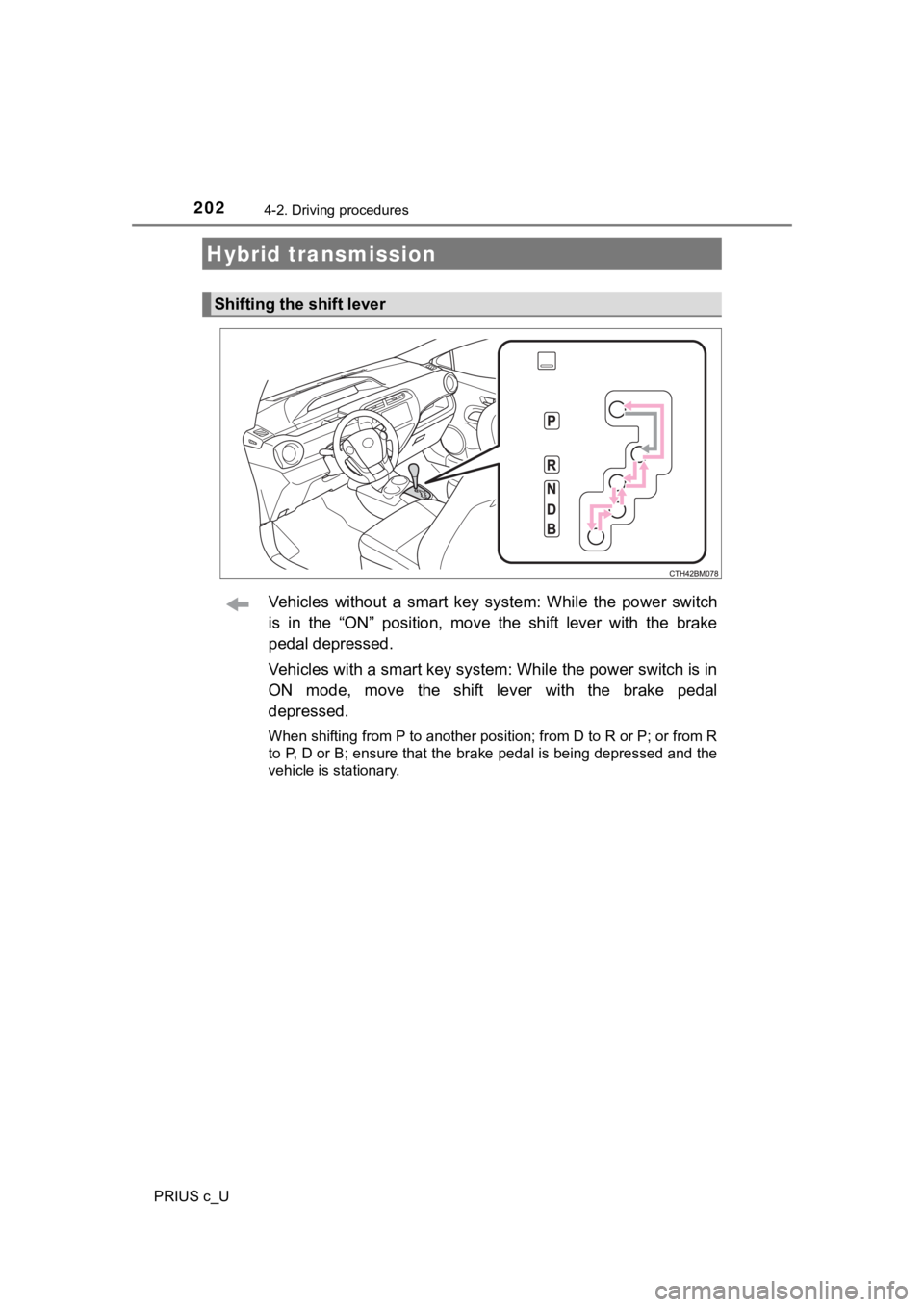
2024-2. Driving procedures
PRIUS c_U
Vehicles without a smart key system: While the power switch
is in the “ON” position, move the shift lever with the brake
pedal depressed.
Vehicles with a smart key system: While the power switch is in
ON mode, move the shift lever with the brake pedal
depressed.
When shifting from P to another position; from D to R or P; or from R
to P, D or B; ensure that the brake pedal is being depressed an d the
vehicle is stationary.
Hybrid transmission
Shifting the shift lever
Page 203 of 600

2034-2. Driving procedures
4
Driving
PRIUS c_U
*: To improve fuel efficiency and reduce noises, set the shift lever in the D
position for normal driving.
Suitable for enhancing the fuel economy, because the torque cor re-
sponding to the accelerator pedal depression amount can be gene r-
ated more smoothly than it is in normal conditions and the oper ation
of the air conditioning system ( heating/cooling) will be minimized.
Eco drive mode
When Eco drive mode is turned on,
the “ECO MODE” indicator will
come on.
Pressing the Eco drive mode
switch again turns Eco drive mode
off.
■ Operation of the air conditioning system in Eco drive mode
Eco drive mode controls the heating/cooling operations and fan speed of the
air conditioning system to enhance fuel efficiency. ( P. 376) To improve air
conditioning performance, adjust the temperature setting or fan speed, or turn
off Eco drive mode.
■ When the accelerator p edal is depressed while the shift position is in N
A buzzer will sound to inform the driver that the shift positio n is in N.
Shift position purpose
Shift positionFunction
PParking the vehicle/starting the hybrid system
RReversing
NNeutral
DNormal driving*
BPosition for engine braking
Selecting Eco drive mode
Page 204 of 600
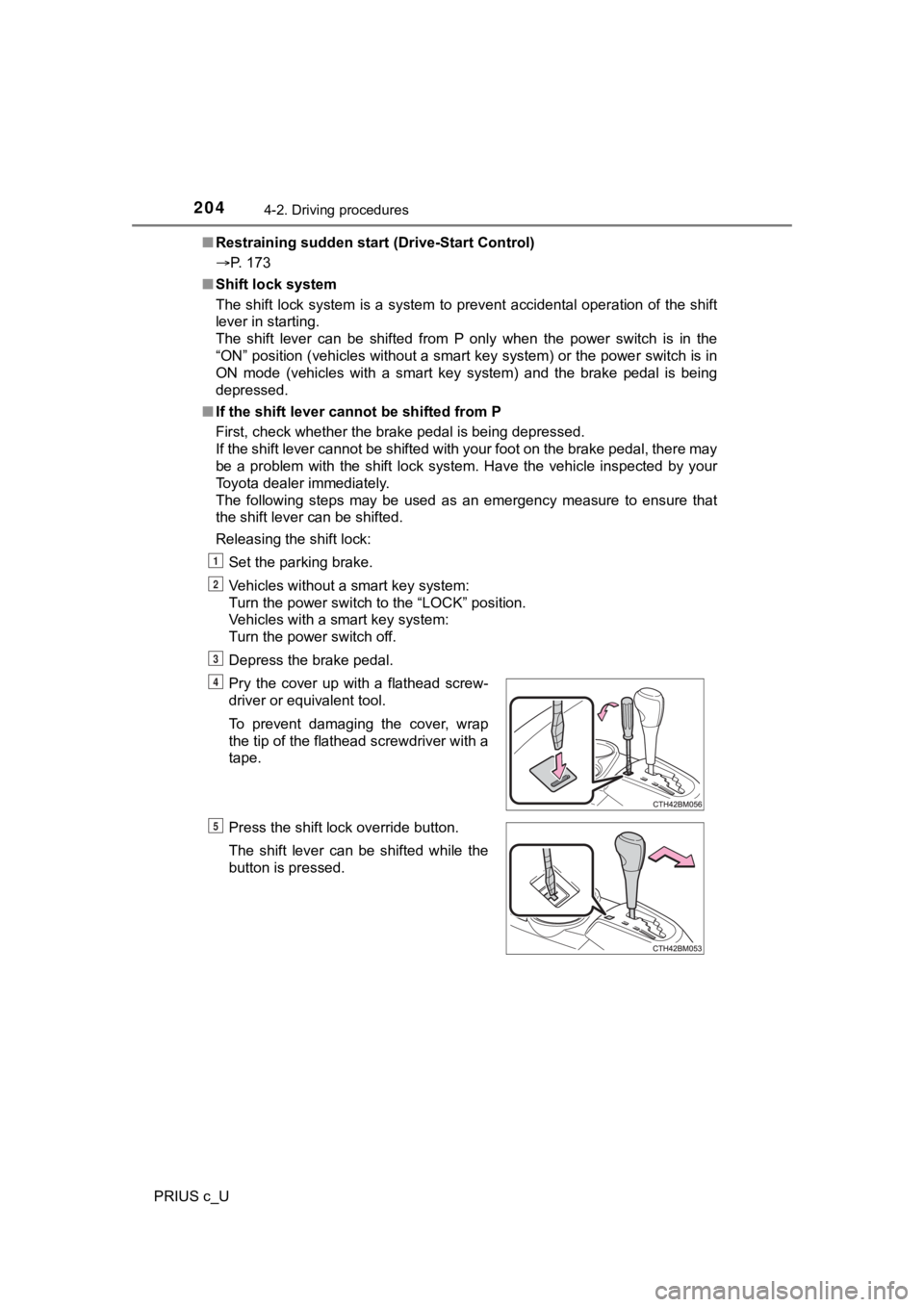
2044-2. Driving procedures
PRIUS c_U■
Restraining sudden start (Drive-Start Control)
P. 173
■ Shift lock system
The shift lock system is a system to prevent accidental operation of the shift
lever in starting.
The shift lever can be shifted from P only when the power switc h is in the
“ON” position (vehicles without a smart key system) or the power switch is in
ON mode (vehicles with a smart key system) and the brake pedal is being
depressed.
■ If the shift lever cannot be shifted from P
First, check whether the brake pedal is being depressed.
If the shift lever cannot be shifted with your foot on the brak e pedal, there may
be a problem with the shift lock system. Have the vehicle inspected by your
Toyota dealer immediately.
The following steps may be used as an emergency measure to ensu re that
the shift lever can be shifted.
Releasing the shift lock:
Set the parking brake.
Vehicles without a smart key system:
Turn the power switch to the “LOCK” position.
Vehicles with a smart key system:
Turn the power switch off.
Depress the brake pedal.
Pry the cover up with a flathead screw-
driver or equivalent tool.
To prevent damaging the cover, wrap
the tip of the flathead screwdriver with a
tape.
Press the shift lock override button.
The shift lever can be shifted while the
button is pressed.
1
2
3
4
5
Page 205 of 600
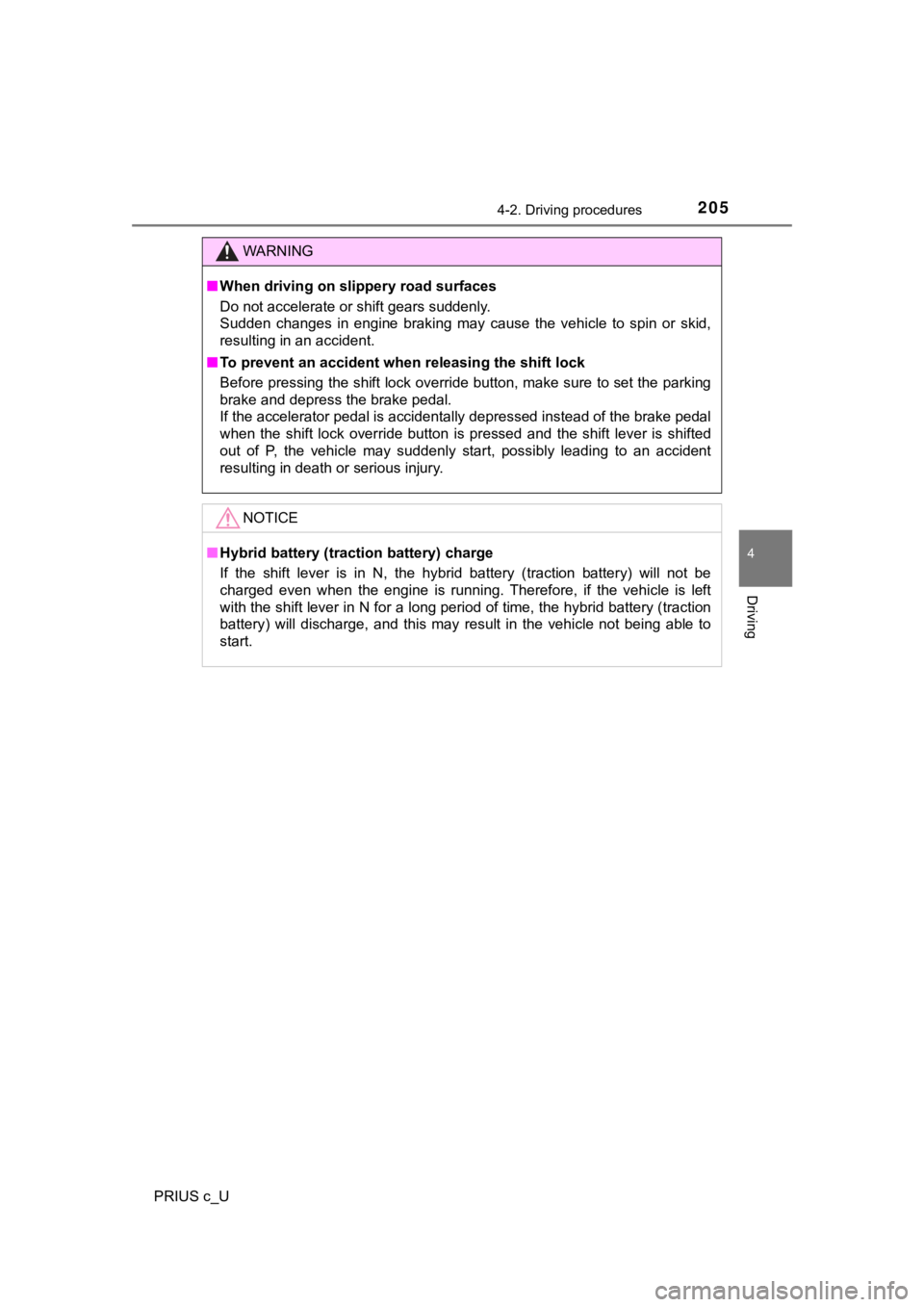
2054-2. Driving procedures
4
Driving
PRIUS c_U
WARNING
■When driving on slippery road surfaces
Do not accelerate or shift gears suddenly.
Sudden changes in engine braking may cause the vehicle to spin or skid,
resulting in an accident.
■ To prevent an accident when releasing the shift lock
Before pressing the shift lock override button, make sure to se t the parking
brake and depress the brake pedal.
If the accelerator pedal is accidentally depressed instead of t he brake pedal
when the shift lock override button is pressed and the shift le ver is shifted
out of P, the vehicle may suddenly start, possibly leading to a n accident
resulting in death or serious injury.
NOTICE
■ Hybrid battery (tract ion battery) charge
If the shift lever is in N, the hybrid battery (traction batter y) will not be
charged even when the engine is running. Therefore, if the vehi cle is left
with the shift lever in N for a long period of time, the hybrid battery (traction
battery) will discharge, and this may result in the vehicle not being able to
start.
Page 206 of 600

2064-2. Driving procedures
PRIUS c_U
Right turn
Lane change to the right (push
and hold the lever partway)
The right hand signals will flash
until you release the lever.
Lane change to the left (push
and hold the lever partway)
The left hand signals will flash until
you release the lever.
Left turn
■Turn signals can be operated when
Vehicles without a smart key system
The power switch is in the “ON” position.
Vehicles with a smart key system
The power switch is in ON mode.
■ If the indicator flashes faster than usual
Check that a light bulb in the front or rear turn signal lights has not burned
out.
Turn signal lever
Operating instructions
1
2
3
4
Page 207 of 600

2074-2. Driving procedures
4
Driving
PRIUS c_U
To set the parking brake, fully
pull the parking brake lever
while depressing the brake
pedal.
To release the parking brake,
slightly raise the lever and
lower it completely while press-
ing the button.
■Parking the vehicle
P. 172
■ Parking brake engaged warning buzzer
A buzzer will sound if the vehicle is driven at a speed of appr oximately 3 mph
(5 km/h) or more with the parking brake engaged. ( P. 481, 492)
■ Usage in winter time
P. 274
Parking brake
Operating instructions
U.S.A. Canada
1
2
NOTICE
■Before driving
Fully release the parking brake.
Driving the vehicle with the parking brake set will lead to bra ke components
overheating, which may affect braking performance and increase brake
wear.
Page 208 of 600
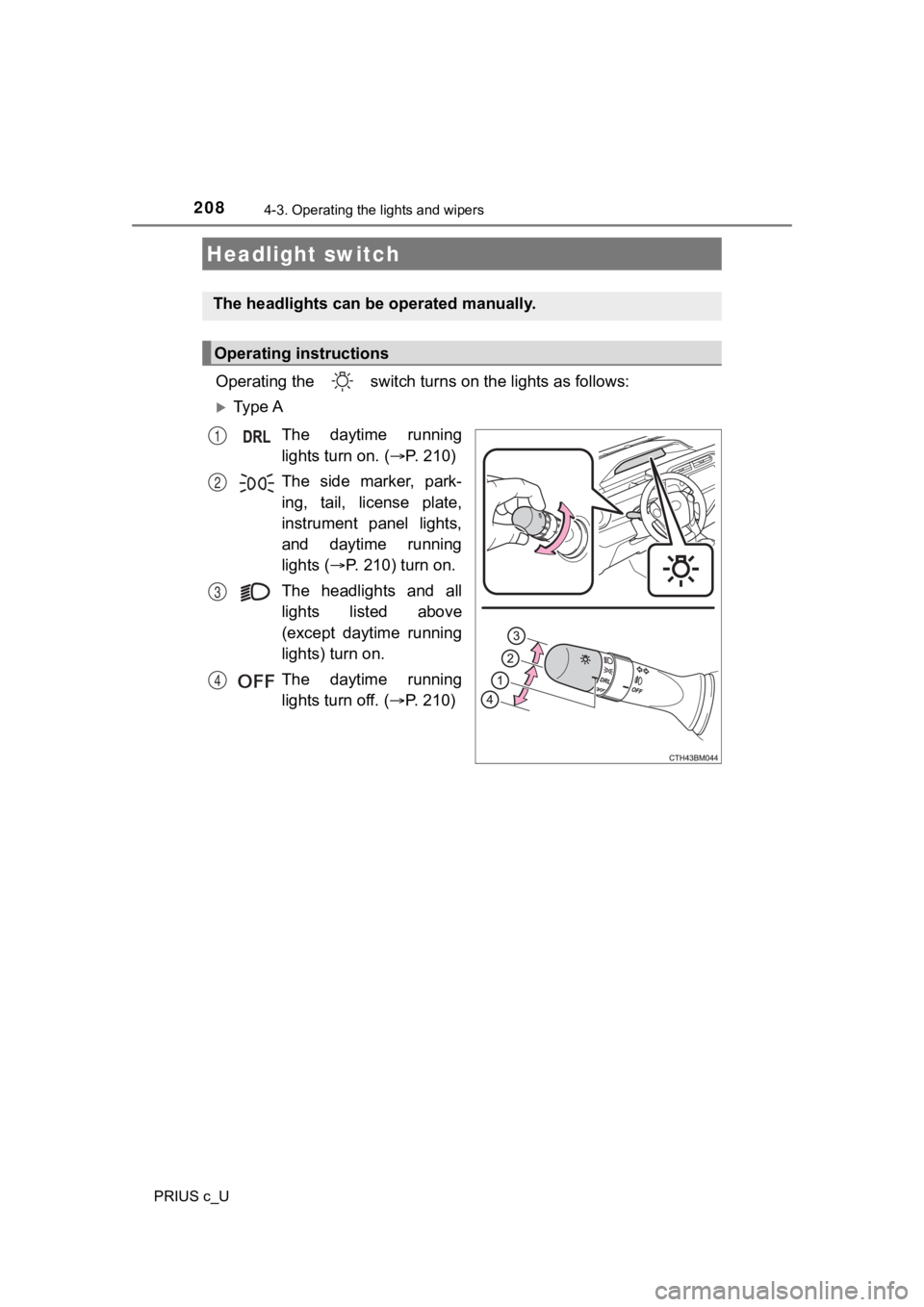
208
PRIUS c_U
4-3. Operating the lights and wipers
Operating the switch turns on the lights as follows:
Ty p e A
The daytime running
lights turn on. ( P. 210)
The side marker, park-
ing, tail, license plate,
instrument panel lights,
and daytime running
lights ( P. 210) turn on.
The headlights and all
lights listed above
(except daytime running
lights) turn on.
The daytime running
lights turn off. ( P. 2 1 0 )
Headlight switch
The headlights can be operated manually.
Operating instructions
1
2
3
4
Page 209 of 600
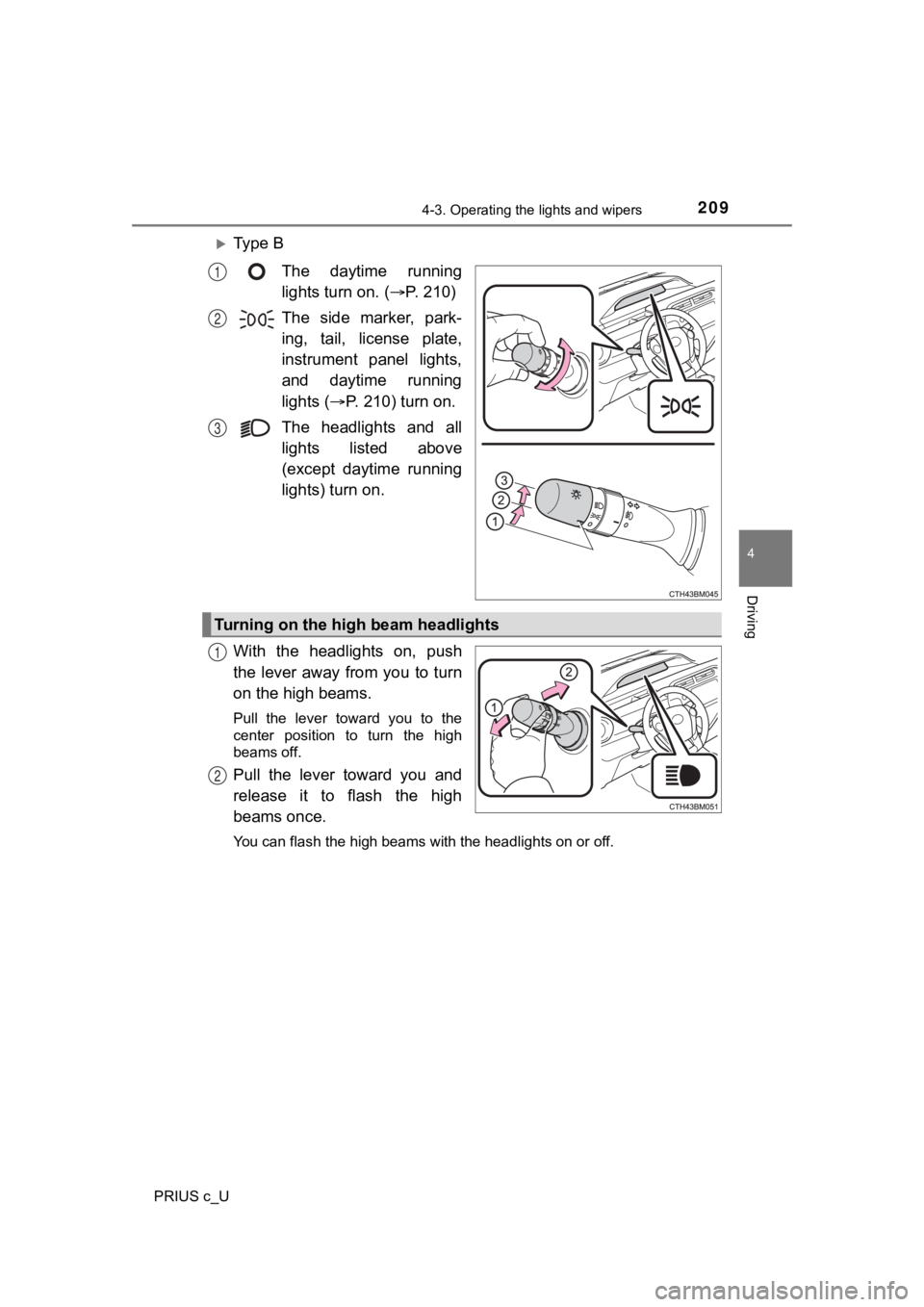
2094-3. Operating the lights and wipers
4
Driving
PRIUS c_U
Ty p e B
The daytime running
lights turn on. ( P. 210)
The side marker, park-
ing, tail, license plate,
instrument panel lights,
and daytime running
lights ( P. 210) turn on.
The headlights and all
lights listed above
(except daytime running
lights) turn on.
With the headlights on, push
the lever away from you to turn
on the high beams.
Pull the lever toward you to the
center position to turn the high
beams off.
Pull the lever toward you and
release it to flash the high
beams once.
You can flash the high beams with the headlights on or off.
1
2
3
Turning on the high beam headlights
1
2
Page 210 of 600
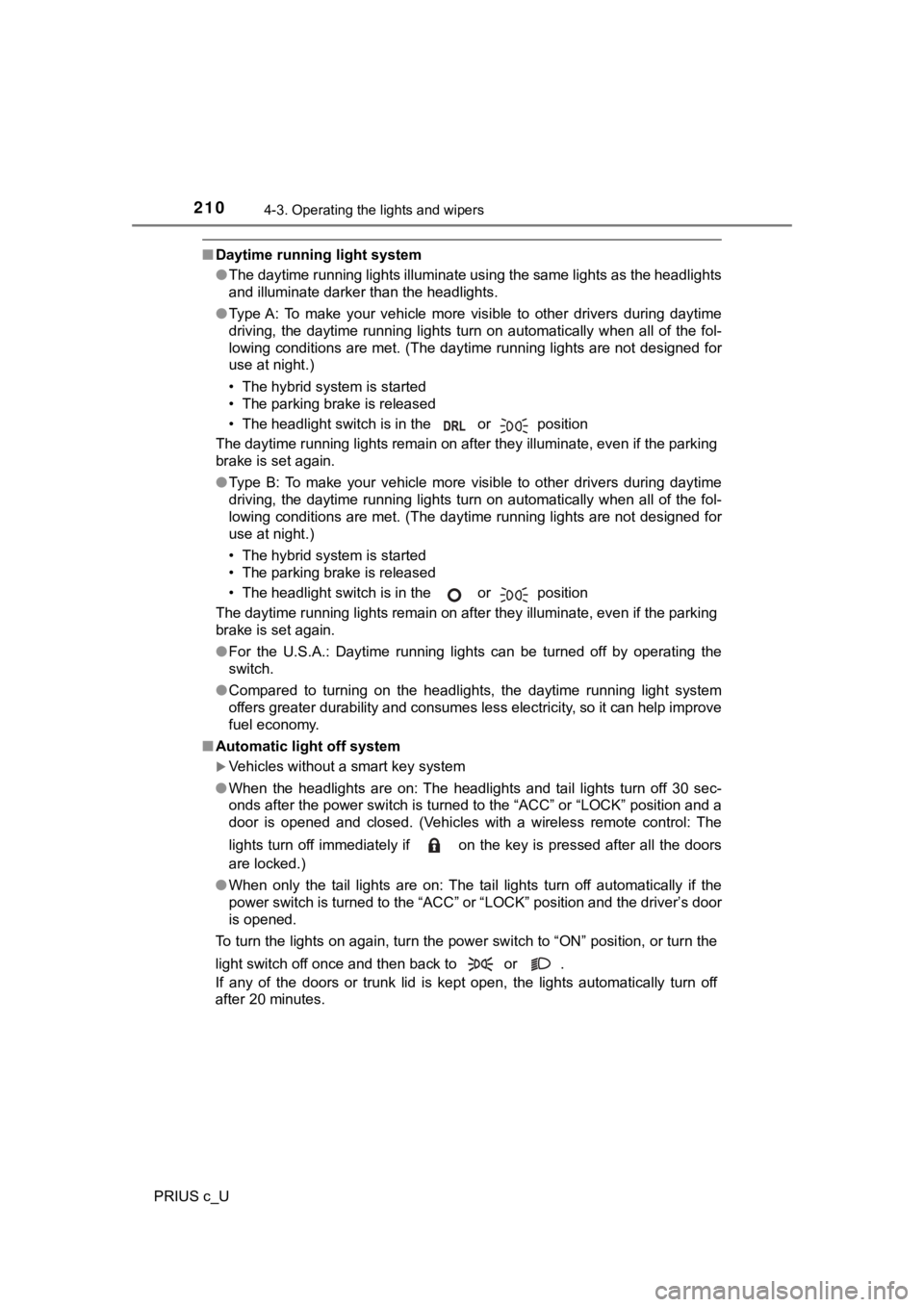
2104-3. Operating the lights and wipers
PRIUS c_U
■Daytime running light system
●The daytime running lights illuminate using the same lights as the headlights
and illuminate darker than the headlights.
● Type A: To make your vehicle more visible to other drivers during daytime
driving, the daytime running lights turn on automatically when all of the fol-
lowing conditions are met. (The daytime running lights are not designed for
use at night.)
• The hybrid system is started
• The parking brake is released
• The headlight switch is in the or position
The daytime running lights remain on after they illuminate, even if the parking
brake is set again.
● Type B: To make your vehicle more visible to other drivers during daytime
driving, the daytime running lights turn on automatically when all of the fol-
lowing conditions are met. (The daytime running lights are not designed for
use at night.)
• The hybrid system is started
• The parking brake is released
• The headlight switch is in the or position
The daytime running lights remain on after they illuminate, even if the parking
brake is set again.
● For the U.S.A.: Daytime running lights can be turned off by ope rating the
switch.
● Compared to turning on the headlights, the daytime running ligh t system
offers greater durability and consumes less electricity, so it can help improve
fuel economy.
■ Automatic light off system
Vehicles without a smart key system
● When the headlights are on: The headlights and tail lights turn off 30 sec-
onds after the power switch is turned to the “ACC” or “LOCK” po sition and a
door is opened and closed. (Vehicles with a wireless remote con trol: The
lights turn off immediately if on the key is pressed after all the doors
are locked.)
● When only the tail lights are on: The tail lights turn off automatically if the
power switch is turned to the “ACC” or “LOCK” position and the driver’s door
is opened.
To turn the lights on again, turn the power switch to “ON” posi tion, or turn the
light switch off once and then back to or .
If any of the doors or trunk lid is kept open, the lights automatically turn off
after 20 minutes.